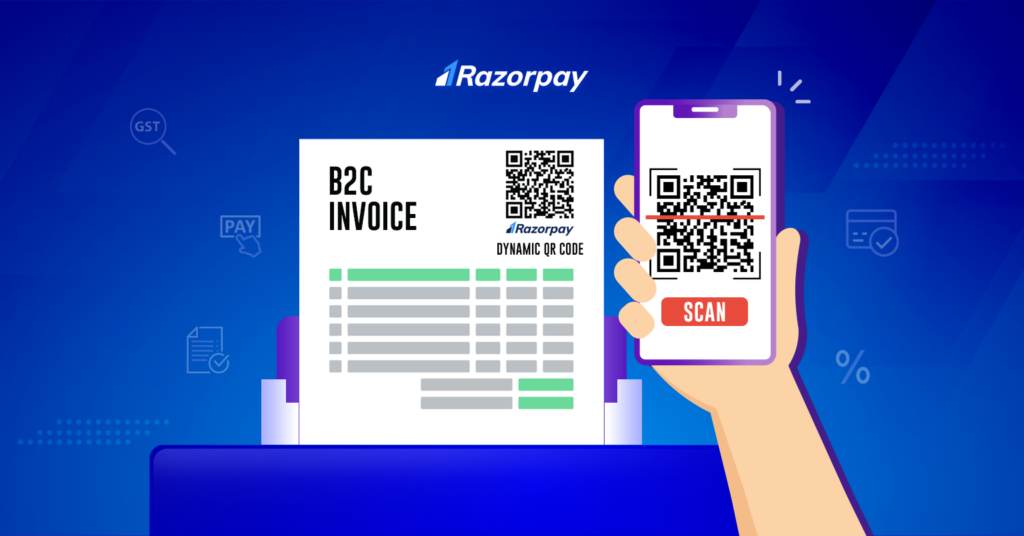In line with the ‘Digital India’ vision, the government introduced GST-compliant dynamic QR codes for B2C e-invoices. The CBIC mandated that businesses with a turnover over ₹500 crore must include these codes on B2C invoices. Understanding this notification is crucial for businesses to comply with the law. Embracing these changes will enhance transparency, efficiency and compliance in the payments industry, aligning with the digital transformation drive.
Table of Contents
What is a Dynamic QR Code?
A QR code is a quick response code that contains coded information about an e-invoice. A dynamic QR code under GST is unique to each invoice generated and expires once the payment is made. The main aim of generating dynamic QR codes for B2C e-invoices is to encourage digital payments using UPI.
You can instantly validate a GSTIN number using the free Razorpay GSTIN Number Search & Verification Tool, which helps you verify the authenticity of a GST number online.
What is in the Dynamic QR Code?
A dynamic QR code under GST contains important details about an invoice, such as –
1. Invoice Details
- Invoice Number: A special number that identifies the invoice
- Invoice Date: The date when the invoice was created
- Due Date: The last date by which the payment needs to be made
2. Merchant Details
- Seller’s GST Number: A unique number given to the seller for tax purposes
- Seller’s Business Name and Address: Details about the company that issued the invoice
3. Buyer Details
- Buyer’s GST Number: Buyer’s GSTIN (if applicable)
- Buyer’s Name and Address: Information about the person or company that needs to make the payment
4. Itemised Product / Service Details
- Description: A list of all the items or services included in the invoice
- Quantity and Unit: Details about the number of each item and the unit of measurement
- Rate and Total Amount: The price of each item and the total bill
5. Tax Details
- Tax Breakdown: Overview of applicable taxes, including income, sales, property and corporate taxes.
- IGST, CGST, and SGST: Specific tax components based on whether the transaction is within the same state or between different states. For intra-state transactions, Central GST (CGST) and State GST (SGST) apply, with rates varying across items. Additionally, inter-state transactions attract Integrated GST (IGST), a combined levy of CGST and SGST rates.
Related Read: What is the Difference Between CGST, SGST and IGST
6. Total Payable Amount
The complete amount, including all items and taxes, that the buyer needs to pay.
7. Payment Information
Information about the seller’s bank account for payment, as indicated on the invoice.
8. Dynamic Element
Incorporating a unique identifier or digital signature to guarantee authenticity and prevent tampering.
Related Read: CGST, SGST, IGST, and UTGST: Full Form, Meaning, and Examples
What is the Role of Dynamic QR Codes in B2C Invoicing?
The main purpose of forming QR codes for B2C (Business-to-Customer) e-invoices is to support digital payments through the various UPI (Unified Payments Interface) methods.
A dynamic QR code, characterised by its editability, introduces advanced features like scan analytics, password protection, device-based redirection and access management. This dynamic functionality enhances the efficiency and security of digital transactions. Dynamic QR codes provide a less dense image, ensuring reliable scanning.
Understanding QR Code Implementation in B2C Invoices
B2C QR codes are created by taxpayers themselves and are made specifically for B2C transactions. You don’t need an Invoice Reference Number (IRN) for B2C invoices. If you submit B2C invoices to the Invoice Registration Portal (IRP), they will automatically be rejected. Repeatedly submitting them could block your ability to generate IRNs.
What is the Latest Government Mandate on Using Dynamic QR Codes for Businesses?
B2C transactions are the supplies made to an unregistered person or consumers, and the invoices where the end-user will not be claiming input tax credit are referred to as B2C invoices. Currently, B2C invoices are exempt from e-invoicing.
The latest CBIC notification, CBEC-20/16/38/2020-GST, directs all taxpayers with an annual turnover of more than ₹500 crore in any preceding financial year (starting 2017-18) to compulsorily generate a dynamic QR code for B2C invoices to enable digital payments on all B2C invoices. Any failure to comply starting October 1, 2021, may attract a penalty of ₹25,000 leviable for incorrect invoicing under Section 125 of the CGST Act.
What is Required to Make a Dynamic QR Code GST – Compliant?
In terms of Notification No. 14/2020-Central Tax, dated March 21, 2020, the following information is required to be coded on the dynamic QR code to make it GST-compliant:
- Supplier GSTIN number
- Supplier UPI ID
- Payee’s A/C number and IFSC
- Invoice number and date
- Total Invoice Value
- GST amount and breakup, i.e. CGST, SGST, IGST, CESS, etc.
The dynamic QR code should be such that it can be scanned to make a digital payment.
Want to know what is GST? Check out this GST invoice guide for all you need to know about GST, like proper documentation, undergoing GST verification, and completing GST registration. You can also calculate the GST amount to be paid and the breakdown of CGST, SGST, and IGST with Razorpay’s Free GST Calculator tool.
Which Businesses are Required to Generate GST-Compliant Dynamic QR Codes?
As explained above, the notification will apply to your business if you (a registered person) issue a tax invoice to an unregistered person (B2C invoice) and your annual aggregate turnover exceeds ₹500 crore in any FY2017-18 onwards.
However, the said notification does not apply to an invoice issued in the following cases –
- An insurer, a banking company or a financial institution, including a non-banking financial company
- A goods transport agency supplying services to the transportation of goods by road in a goods carriage
- Supplying passenger transportation service
- Supplying services by way of admission to the exhibition of cinematography in films on multiplex screens
Penalty Provisions for Non-Compliance with B2C QR Code Requirements
The requirement for B2C QR code was originally slated for October 1, 2020, but it became effective on December 1, 2020, as per GST Notification No.71/2020. There was a penalty waiver for non-compliance until March 31, 2021.
For enterprises which fail to implement a B2C QR Code following April 1, 2021, a penalty of ₹25,000 is applicable under Section 125 of the GST Act.
How is Razorpay’s GST-Compliant Dynamic QR Code Solving the Problem?
Since the dynamic QR code is to be generated by taxpayers, it can seem like a daunting task. What if we tell you that Razorpay has developed a simplified solution for this problem?
Razorpay QR codes let you generate GST-compliant dynamic QR codes for your B2C e-invoicing process. They can be easily generated via API and you will soon be able to generate them via the Razorpay dashboard.
Razorpay QR codes come loaded with a host of features like:
- Clean and defined APIs with multiple parameters for tracking and reconciliation
- Option to set expiry dates and close QR codes post-usage
- QR codes specific to each customer for tracking payments and usage
- Payment reconciliation in real-time for all QR-based payments using dashboard reports
- Branded UPI QR code with company name, logo and custom merchant VPA (virtual payment address)
- Real-time notifications and webhooks for tracking payments
- Interoperable QR codes, meaning payments can be made from any UPI app (like PhonePe, Google Pay, BHIM, etc.)
How to Create GST-Compliant Dynamic QR Codes with Razorpay APIs?
1. Log in to your Razorpay Account
 2. In the left sidebar menu, navigate to Settings → API Keys → Generate Keys
2. In the left sidebar menu, navigate to Settings → API Keys → Generate Keys
 3. After generating the keys from the dashboard, download and save them securely. If you do not remember your API Keys, re-generate them from the dashboard and replace them wherever required. Do not share your API Key secret with anyone or on public platforms.
3. After generating the keys from the dashboard, download and save them securely. If you do not remember your API Keys, re-generate them from the dashboard and replace them wherever required. Do not share your API Key secret with anyone or on public platforms.
4. Use these keys to start using Razorpay APIs and generate dynamic QR code for B2C invoices.
5. You can track payments received on these dynamic QR codes using the Razorpay dashboard for easy reconciliation.
You can read about the detailed step-by-step process in the Dynamic QR Code Under GST Doc.
We at Razorpay continuously strive to build products that can help you focus on your business growth while we focus on solving your business challenges!
Conclusion
Creating dynamic QR codes for B2C invoices is a step in embracing digital payments and aligning with the government’s vision for ‘Digital India’. Utilising tools like Razorpay QR code generation APIs can help your business ensure compliance, transparency and a secure customer payment experience. Implementing dynamic QR codes streamlines invoicing processes. It supports the transformation of the payments industry, promoting efficiency and progress towards a cashless economy.
Frequently Asked Questions (FAQs)
1. Why is a dynamic QR code mandatory for GST invoices?
A dynamic QR code creates transparency and facilitates the verifying processes for taxing authorities. It contains essential invoice information like GSTIN, invoice number and tax amount, thus allowing easy monitoring and verification of transactions.
2. Is a dynamic QR code different for B2B and B2C transactions?
Yes, dynamic QR codes may differ for B2B and B2C transactions. For a B2B transaction, details like the GSTIN of the buyer and seller need to be added, while for B2C transactions, the focus will be on the invoice essentials for consumer reference.
3. Why is a dynamic QR code required for GST compliance?
A dynamic QR code is essential for GST compliance to ensure reporting and transaction transparency. It simplifies the verification of invoices by tax authorities, prevents tax evasion and streamlines the GST compliance process for businesses.
4. How does a dynamic QR code differ from a static QR code in the context of GST?
A dynamic QR code in GST invoice includes real-time invoice details that can be updated, while a static QR code contains fixed information that does not change. Dynamic QR codes offer flexibility, enable real-time transaction tracking and ensure adherence to evolving GST regulations.
5. Which businesses are mandated to use dynamic QR codes under GST regulations?
Businesses with a turnover more than ₹500 crore need to adopt dynamic QR codes as per GST regulations.
6. Are there specific guidelines or standards for generating Dynamic QR codes under GST?
Yes there are guidelines issued by the Central Board of Indirect Taxes and Customs (CBIC). These guidelines prescribe that authorised persons with an aggregate turnover above ₹500 crore annually must include a QR code on B2C invoices. The QR code should present information providing supplier GSTIN, supplier UPI ID, payee bank account number and IFSC, invoice number and date, total invoice value, GST amount, etc. Furthermore, the dynamic QR code should be scannable for digital payments.
7. How does a dynamic QR code contribute to the efficiency of B2C invoicing under GST?
Dynamic QR codes promote efficiency in B2C invoicing by allowing customers to check invoices immediately. They contain all the essential invoice details and can, therefore, be used by customers to reconcile their purchases.
8. How can businesses integrate dynamic QR codes into their existing invoicing systems for GST compliance?
You can generate dynamic QR codes into your business’s invoice system using software. This integration helps avoid inconsistency and smoothens the invoicing process for businesses and customers.


